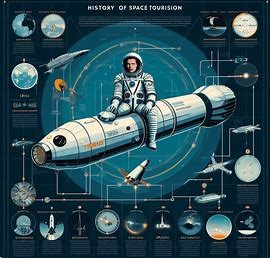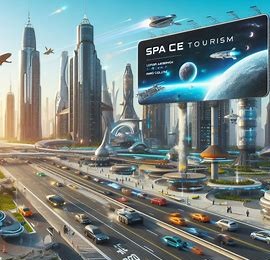In the history, there have been moments that forever altered our perspective of the world. The first-time humans took flight, broke the sound barrier, or set foot on the Moon were such moments. Today, we stand on the precipice of a new frontier in travel – space tourism.

This industry, in its nascent stage, has the potential to redefine how we explore and experience the cosmos. In this blog, we’ll delve deep into the fascinating world of space tourism, exploring its history, the experiences it offers, the environmental challenges it presents, and its exciting future.
A Brief History of Space Tourism

The concept of space tourism isn’t a recent one. The dream of venturing beyond our planet has captivated human minds for centuries. However, it wasn’t until the early 21st century that this dream began to materialize.
The pioneer of space tourism, Dennis Tito, etched his name in history in 2001 as the first private individual to embark on a space adventure. Tito’s journey to the International Space Station (ISS) marked the dawn of a new era. Since that groundbreaking moment, more than 20 individuals have followed in his footsteps, experiencing the thrill of space travel as tourists.
The Cosmic Price Tag: Costs of Space Tourism

Space tourism, though promising, has remained an exclusive privilege for the financially elite. The cost of a ticket to the stars is a significant barrier to entry. As of now, suborbital space tourism flights, which offer a few minutes of weightlessness and Earth’s curvature, come with a hefty price tag of around $250,000. For orbital space tourism, the price skyrockets to around $50 million.
However, there is a glimmer of hope on the horizon. Industry experts believe that as space tourism matures and becomes more commonplace, costs will likely decrease. This could usher in a new era where space tourism is accessible to a broader range of enthusiasts, not just the super-wealthy.
Requirements for Space Tourists

Not everyone can simply buy a ticket and hop on a spaceship to the cosmos. Space tourism companies have stringent requirements for their passengers, ensuring their physical and mental readiness for the journey. Potential space tourists must:
- Be in good physical health to withstand the physical stresses of space travel.
- Be mentally prepared for the unique challenges and isolation of space.
- Pass background checks to ensure the safety of the mission and fellow passengers.
- Undergo rigorous training to familiarize themselves with the spacecraft, emergency procedures, and the experience of spaceflight.
These prerequisites are vital to ensure the safety and well-being of space tourists during their exhilarating journeys.
The Journey: Experiencing Space Tourism

The allure of space tourism lies in the unparalleled experiences it offers. Whether it’s a suborbital jaunt or an orbital sojourn, space tourists are treated to awe-inspiring moments:
- Weightlessness: Perhaps the most enchanting aspect of space tourism is the sensation of weightlessness. In suborbital flights, passengers experience a few minutes of floating, akin to astronauts aboard the ISS. This otherworldly feeling, often described as euphoric, is a highlight of the journey.
- The Earth from Space: Space tourists have the privilege of gazing upon our planet from a vantage point few have seen. The view of Earth’s curvature against the backdrop of space is a sight that leaves a lasting impression and deepens one’s connection to our fragile planet.
- Scientific Engagement: Some space tourism programs offer participants the opportunity to conduct experiments or contribute to scientific research during their journey. This hands-on involvement can be profoundly fulfilling for those with a passion for science.
Beyond the Stars: Future Visions of Space Tourism

Space tourism is still in its infancy, but its potential is boundless. Here are some exciting possibilities for the future:
- Space Hotels and Habitats: As space tourism grows, the demand for accommodations and extended stays in space is likely to rise. The concept of space hotels and habitats is not far-fetched. These structures could serve tourists, researchers, and entrepreneurs alike, providing a new dimension to space living.
- Advanced Space Transportation: Innovation in space transportation is inevitable. The development of reusable rockets and spacecraft could significantly reduce the costs of space travel and expand its accessibility.
- Environmental Sustainability: Space tourism is not without its environmental concerns. Rocket launches produce emissions and contribute to space debris. However, the indust
Space Tourism and the Environment

The environmental impact of space tourism is a topic that warrants careful consideration. It presents both opportunities and challenges.
On the positive side, space tourism companies are working to develop environmentally friendly technologies. Some are exploring rockets that use cleaner fuels, emit fewer pollutants, and produce less greenhouse gas emissions. This could contribute to a more sustainable future for space travel.
However, there are concerns about the environmental footprint of space tourism. The potential increase in space debris poses a hazard to both spacecraft and astronauts. Additionally, rocket launches emit greenhouse gases that contribute to climate change. As the industry expands, addressing these challenges becomes imperative.
Here are some specific examples of space tourism companies and the services they offer

- Virgin Galactic: Virgin Galactic is developing a suborbital spacecraft called SpaceShipTwo. SpaceShipTwo will carry six passengers and two pilots to the edge of space, where they will experience weightlessness for a few minutes and see the curvature of the Earth. Virgin Galactic is expected to begin commercial flights in 2023.
- SpaceX: SpaceX is developing a Starship spacecraft that is capable of both suborbital and orbital flight. SpaceX has announced plans to offer suborbital space tourism flights in the near future.
- Blue Origin: Blue Origin is developing a New Shepard spacecraft that is capable of suborbital flight. New Shepard will carry six passengers to the edge of space, where they will experience weightlessness for a few minutes and see the curvature of the Earth. Blue Origin began commercial flights in 2021.
Other companies that are developing space tourism services include:
- Axiom Space
- Bigelow Aerospace
- Momentus Space
- Sierra Space
- Virgin Orbit
additional thoughts on the future of space tourism

- Space tourism could become a major source of revenue for space companies. This revenue could be used to fund the development of new spacecraft and technologies, which would benefit the entire space industry.
- Space tourism could also help to make space more accessible to people from all walks of life. As the cost of space travel comes down, more and more people will have the opportunity to experience the wonders of space.
- Space tourism could also have a positive impact on Earth
Conclusion: Navigating the Cosmos with Caution and Enthusiasm

Space tourism represents a thrilling frontier in travel, one that has the power to reshape our understanding of our place in the universe. From its humble beginnings with Dennis Tito to the ambitious projects of today’s space tourism companies, the industry continues to evolve.
for more knowledge click here—> Read New




Leave a Reply